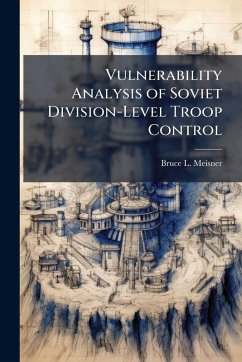
Emerging Soviet Doctrine
Implications for the U.S. Task Force Defense
Versandkostenfrei!
Versandfertig in über 4 Wochen
15,99 €
inkl. MwSt.

PAYBACK Punkte
8 °P sammeln!
This monograph discusses selected aspects of Soviet offensive doctrine with emphasis on trends discussed in unclassified literature. Relevant U.S. heavy task force doctrine is then reviewed in light of what the Soviets are doing and the implications for defense are highlighted. Subjects addressed in this paper include Soviet use of surprise, tempo, mobile groups, fire support and helicopters, and sophisticated combined arms tactics to deal with U.S. defenses. Soviet concerns over "nuclear-like" weapons are discussed along with relative views of a future high intensity battlefield. Possible are...
This monograph discusses selected aspects of Soviet offensive doctrine with emphasis on trends discussed in unclassified literature. Relevant U.S. heavy task force doctrine is then reviewed in light of what the Soviets are doing and the implications for defense are highlighted. Subjects addressed in this paper include Soviet use of surprise, tempo, mobile groups, fire support and helicopters, and sophisticated combined arms tactics to deal with U.S. defenses. Soviet concerns over "nuclear-like" weapons are discussed along with relative views of a future high intensity battlefield. Possible areas of concern for U.S. doctrine developers are identified and discussed along with some ideas for adapting our training to reflect current Soviet doctrine. The paper concludes that tactical surprise is likely to be achieved by the Soviets, and that training and doctrine should reflect this situation. The paper also questions the validity of the assertion that a task force can defeat a regiment, not because of deficiencies in U.S. doctrine or equipment, but as a function of high intensity mobile warfare. In addition, the monograph suggests changing the composition of the OPFOR at the NTC from a rifle regiment to a tank regiment, in order to more closely model emerging Soviet doctrine. This work has been selected by scholars as being culturally important, and is part of the knowledge base of civilization as we know it. This work was reproduced from the original artifact, and remains as true to the original work as possible. Therefore, you will see the original copyright references, library stamps (as most of these works have been housed in our most important libraries around the world), and other notations in the work. This work is in the public domain in the United States of America, and possibly other nations. Within the United States, you may freely copy and distribute this work, as no entity (individual or corporate) has a copyright on the body of the work. As a reproduction of a historical artifact, this work may contain missing or blurred pages, poor pictures, errant marks, etc. Scholars believe, and we concur, that this work is important enough to be preserved, reproduced, and made generally available to the public. We appreciate your support of the preservation process, and thank you for being an important part of keeping this knowledge alive and relevant.








![The Soviet History of World War II [1959] Cover The Soviet History of World War II [1959]](https://bilder.buecher.de/produkte/70/70252/70252942n.jpg)



